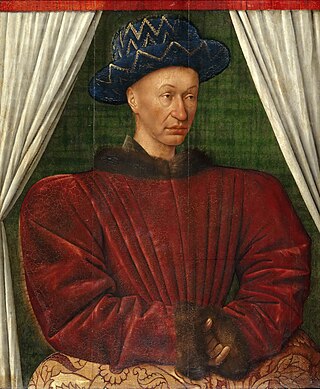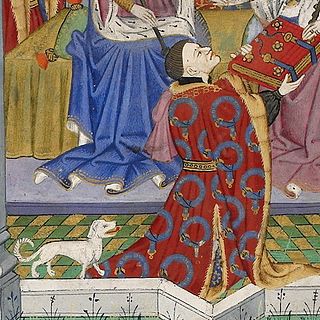
The siege of Orléans marked a turning point of the Hundred Years' War between France and England. The siege took place at the pinnacle of English power during the later stages of the war, but was repulsed by French forces inspired by the arrival of Joan of Arc. The French would then regain the initiative in the conflict and began to recapture territories previously occupied by the English.

Charles VII, called the Victorious or the Well-Served, was King of France from 1422 to his death in 1461. His reign saw the end of the Hundred Years' War and a de facto end of the English claims to the French throne.

John Talbot, 1st Earl of Shrewsbury, 1st Earl of Waterford, 7th Baron Talbot, KG, known as "Old Talbot", was an English nobleman and a noted military commander during the Hundred Years' War. He was the most renowned in England and most feared in France of the English captains in the last stages of the conflict. Known as a tough, cruel, and quarrelsome man, Talbot distinguished himself militarily in a time of decline for the English. Called the "English Achilles" and the "Terror of the French", he is lavishly praised in the plays of Shakespeare. The manner of his death, leading an ill-advised charge against field artillery, has come to symbolize the passing of the age of chivalry. He also held the subsidiary titles of 10th Baron Strange of Blackmere and 6th Baron Furnivalljure uxoris.

John Fitzalan, 7th Earl of Arundel, 4th Baron MaltraversKG was an English nobleman and military commander during the later phases of the Hundred Years' War. His father, John Fitzalan, 3rd Baron Maltravers, fought a long battle to lay claim to the Arundel earldom, a battle that was not finally resolved until after the father's death, when John Fitzalan the son was finally confirmed in the title in 1433.

Peter I of Bourbon was the second Duke of Bourbon, from 1342 to his death. Peter was son of Louis I of Bourbon, whom he also succeeded as Grand Chamberlain of France, and Mary of Avesnes.

Étienne de Vignolles, Sieur de Montmorillon, Chatelain de Longueville, also known as La Hire, was a French military commander during the Hundred Years' War.

The Battle of Patay, fought on 18 June 1429 during the Hundred Years' War, was the culmination of the Loire Campaign between the French and English in north-central France. In this engagement, the horsemen of the French vanguard inflicted heavy casualties on an English army; most of them sustained by the longbowmen as the English cavalry fled. In addition, all but one of the senior English commanders were captured. A victory often credited to Joan of Arc, she was in fact not present for the battle as she had remained with the main body of the French army. The vanguard at Patay was led by La Hire and Jean Poton de Xaintrailles.

Jean Poton de Xaintrailles, a minor noble of Gascon origin, was one of the chief lieutenants of Joan of Arc. He served as master of the royal stables, as royal bailiff in Berry and as seneschal of Limousin. In 1454 he was appointed a Marshal of France. Jean Poton was a leading figure on the French side in the Hundred Years War.

Jean de Brosse (1375–1433), Lord of Boussac, Sainte-Sévère and Huriel, was a councillor and chamberlain to Charles VII of France; he was made a Marshal of France in 1426.

The Battle of Jargeau took place on 11–12 June 1429. It was part of the Loire Campaign during the Hundred Years' War, where the forces of Charles VII of France successfully recaptured much of the region, following their victory at the Siege of Orléans. The battle ended in victory for Charles VII and is notable as Joan of Arc's first offensive battle.

The Battle of Meung-sur-Loire took place on 15 June 1429. It was one of Joan of Arc's battles following relief of the siege at Orléans. This campaign was the second sustained French offensive in a generation in the Hundred Years' War.

The Battle of Beaugency took place on 16 and 17 June 1429. It was one of Joan of Arc's battles. Shortly after relieving the siege at Orléans, French forces recaptured the neighboring district along the Loire river.

The siege of Meaux was fought from October 1421 to May 1422 between the English and the French during the Hundred Years' War. The English were led by King Henry V. Henry became ill while pressing this long siege, which took place during the winter months, and died on 31 August as a result.

The Lancastrian War was the third and final phase of the Hundred Years' War between England and France. It lasted from 1415, when Henry V of England invaded Normandy, to 1453, when the English were definitively defeated in Aquitaine. It followed a long period of peace from the end of the Caroline War in 1389. The phase is named after the House of Lancaster, the ruling house of the Kingdom of England, to which Henry V belonged.

The Loire Campaign was a campaign launched by Joan of Arc during the Hundred Years' War. The Loire was cleared of all English and Burgundian troops.
Charles Antoine Dominique Xaintrailles, also called Anointe-Charles-Dominique de Lauthier de Chabanon Xaintrailles, was a general in the French Revolutionary and Napoleonic wars.

The siege of Paris was an assault undertaken in September 1429 during the Hundred Years' War by the troops of the recently crowned King Charles VII of France, with the notable presence of Joan of Arc, to take the city held by the English and Burgundians. King Charles's French troops failed to enter Paris, defended by the governor Jean de Villiers de L'Isle-Adam and the provost Simon Morhier, with the support of much of the city's population.

After the French lifted the siege of Orléans and won a decisive victory at the Battle of Patay, the English and Burgundians no longer posed a threat. Joan of Arc convinced the Dauphin Charles to go to Reims for his coronation. Successfully marching their army though the heart of territory held by the hostile Burgundians solidified the Dauphin’s regrasp of the throne of France. He had been disinherited from it through the Treaty of Troyes.
The siege of Saint-Denis was the last instance of cooperation between the English and their Burgundian allies in the Hundred Years' War. Saint-Denis, the traditional burial place of the kings of France, was located in the outskirts of English-held Paris, and had been captured by the French a couple of months earlier. The enemy presence there critically endangered the English position in the capital, and, aiming to retake it urgently, the English moved onto the town in August with a handful of Burgundian auxiliaries. The siege was undertaken during the peace congress of Arras, during which no end to the fighting was seen, as both sides struggled to gain ground around and over Paris. The English were victorious at St. Denis after the French garrison surrendered due to lack of external support.

The siege of Paris of 1435-36 took place during the decisive Lancastrian phase of the Hundred Years' War. The resurgent forces of Charles VII of France, having reversed the tide of the conflict, set their sights on capturing the capital, Paris, which had been controlled by forces loyal to Henry VI of England since 1420.

















